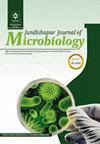Molecular Characteristics and the Effect of Mutations in Different Sites of the rplD Gene Among Clinical Isolates of Azithromycin Resistance Neisseria gonorrhoeae in Eastern China
IF 0.5
4区 医学
Q4 MICROBIOLOGY
引用次数: 0
Abstract
Background: The emergence of resistance to azithromycin complicates the treatment of Neisseria gonorrhoeae, the causative agent of gonorrhea. Objectives: The main objective of this study was to investigate the impact of mutations in different sites of the rplD gene on azithromycin resistance (AZM-R) and the molecular characteristics of N. gonorrhoeae. This study aimed to provide evidence for drug resistance and transmission. Methods: A total of 37 isolates of N. gonorrhoeae were collected within January 2018 to December 2020. These isolates were obtained from urine, semen, or vaginal secretions of different patients. Azithromycin resistance was assessed, and genes associated with AZM-R, namely rplD, and rplV, were analyzed using polymerase chain reaction (PCR) and deoxyribonucleic acid (DNA) sequencing. All clinical isolates were characterized through multi-locus sequence typing (MLST). Results: The study comprised 21 azithromycin-resistant N. gonorrhoeae isolates, with two of them demonstrating high resistance, indicated by a minimum inhibitory concentration (MIC) greater than 256 µg/mL. Additionally, 16 sensitive isolates were included in the study. Ten isolates were observed to have rplD point mutations, including mutations such as G70D, G70S, G68D, and A43T. No mutations were detected in rplV. The rate of point mutations in rplD was significantly different between the azithromycin-sensitive (AZM-S) group and the AZM-R group (P < 0.05). Among the 37 isolates studied, 12 distinct MLST types were identified and further grouped into four different MLST goeBURST groups. The two isolates with high-level AZM-R were ST1901 and ST1588, respectively. Conclusions: The clinical isolates of N. gonorrhoeae from Wenzhou, Eastern China, exhibit significant genetic diversity and a relatively high prevalence of AZM-R. Mutations in the rplD gene were identified, which reduced susceptibility to macrolides and were significantly associated with increased AZM-R.华东地区耐阿奇霉素淋病奈瑟菌临床分离株rplD基因不同位点突变的分子特征及其影响
背景:阿奇霉素耐药性的出现使淋病病原体淋病奈瑟菌的治疗变得复杂。研究目的本研究的主要目的是调查 rplD 基因不同位点的突变对阿奇霉素耐药性(AZM-R)和淋病奈瑟菌分子特征的影响。本研究旨在为耐药性和传播提供证据。研究方法在2018年1月至2020年12月期间共收集了37株淋球菌分离株。这些分离物来自不同患者的尿液、精液或阴道分泌物。通过聚合酶链式反应(PCR)和脱氧核糖核酸(DNA)测序,对阿奇霉素耐药性进行了评估,并分析了与AZM-R相关的基因,即rplD和rplV。通过多焦点序列分型(MLST)对所有临床分离株进行了鉴定。研究结果该研究包括 21 个耐阿奇霉素的淋球菌分离株,其中两个表现出高度耐药性,最低抑菌浓度 (MIC) 超过 256 µg/mL。此外,研究还包括 16 个敏感分离株。观察到 10 个分离株有 rplD 点突变,包括 G70D、G70S、G68D 和 A43T 等突变。在 rplV 中未检测到突变。阿奇霉素敏感(AZM-S)组与 AZM-R 组之间的 rplD 点突变率存在显著差异(P < 0.05)。在研究的 37 个分离株中,发现了 12 种不同的 MLST 类型,并进一步分为 4 个不同的 MLST goeBURST 组。两个具有高水平 AZM-R 的分离物分别是 ST1901 和 ST1588。结论来自中国东部温州的淋球菌临床分离株表现出显著的遗传多样性和较高的 AZM-R 感染率。研究发现,rplD基因突变会降低对大环内酯类药物的敏感性,并与AZM-R的增加显著相关。
本文章由计算机程序翻译,如有差异,请以英文原文为准。
求助全文
约1分钟内获得全文
求助全文
来源期刊

Jundishapur Journal of Microbiology
MICROBIOLOGY-
CiteScore
1.30
自引率
0.00%
发文量
56
审稿时长
6-12 weeks
期刊介绍:
Jundishapur Journal of Microbiology, (JJM) is the official scientific Monthly publication of Ahvaz Jundishapur University of Medical Sciences. JJM is dedicated to the publication of manuscripts on topics concerning all aspects of microbiology. The topics include medical, veterinary and environmental microbiology, molecular investigations and infectious diseases. Aspects of immunology and epidemiology of infectious diseases are also considered.
 求助内容:
求助内容: 应助结果提醒方式:
应助结果提醒方式:


